
Lake Tanganyika is an African Great Lake. It is the second-largest freshwater lake by volume and the second deepest, in both cases after Lake Baikal in Siberia. It is the world's longest freshwater lake. The lake is shared among four countries—Tanzania, the Democratic Republic of the Congo, Burundi, and Zambia—with Tanzania (46%) and the DRC (40%) possessing the majority of the lake. It drains into the Congo River system and ultimately into the Atlantic Ocean.
Reymondia is a genus of freshwater snails, aquatic gastropod mollusks in the family Paludomidae.
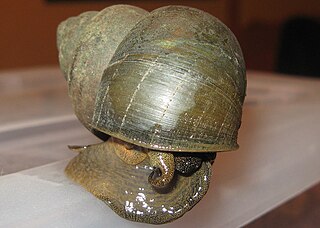
The Chinese mystery snail, black snail, or trapdoor snail, is a large freshwater snail with gills and an operculum, an aquatic gastropod mollusk in the family Viviparidae. The Japanese variety of this species is black and usually a dark green, moss-like alga covers the shell.

Ctenochromis horei is a species of haplochromine cichlid which is found in East Africa.
Beddomeia camensis is a species of very small freshwater snail that is endemic to Australia. The invertebrate is 2-4 mm in size, it is a gastropod mollusk and belongs to the Hydrobiidae family, a large family of freshwater snails recognised by their small size and cosmopolitan distribution. Beddomeia camensis is one of the least populated species within its family distributed across only 5 small to medium-sized streams that flow into the Cam River catchment in North-West Tasmania.
Beddomeia waterhouseae, also known as Claytons Rivulet freshwater snail, is a species of freshwater snail in the family Tateidae. This species is endemic to northern Tasmania in Australia. The holotype specimen was found in a very small tributary of Little Clayton's Rivulet and is held at the Australian Museum. B. waterhouseae is small and as an adult has a shell measuring between 1.7 to 3.7 mm in length. The shell shape is ovate-conic to broadly conic and has a thin inner lip and no columellar bulge. This species feeds on algae and detritus on rocks. The female of the species lay single eggs in capsules made of sand grains and attached to the underside of rocks or wood. B. waterhouseae is considered vulnerable by the IUCN as it has a very small range and is sensitive to water quality and so may be threatened by disturbances of its habitat. Other threats include habitat loss. Conservation activities such as assessment of the aquatic ecosystem and vegetal surveys are being undertaken in an attempt to preserve this species.
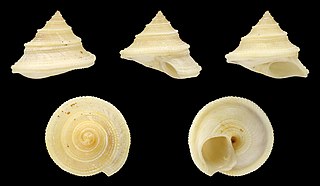
Chytra kirki is a species of tropical freshwater snail with an operculum, aquatic gastropod mollusk in the family Paludomidae.
Coelatura horei is a species of freshwater mussel, an aquatic bivalve mollusk in the family Unionidae, the river mussels.
Limnotrochus is a monotypic genus in the family Paludomidae containing the single species Limnotrochus thomsoni, a tropical freshwater snail with gills and an operculum, aquatic gastropod mollusk. It is endemic to Lake Tanganyika.
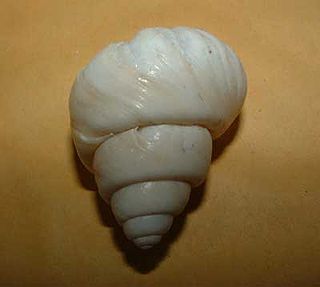
Neothauma is a genus of freshwater snail with a gill and an operculum, an aquatic gastropod mollusc in the subfamily Bellamyinae of the family Viviparidae.
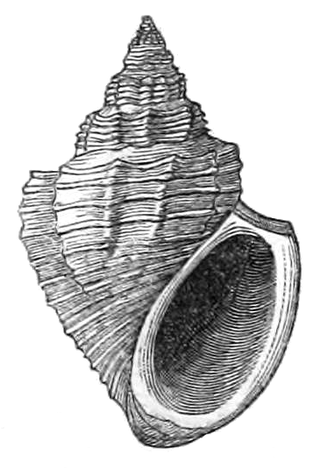
Paramelania damoni is a species of tropical freshwater snail with an operculum, an aquatic gastropod mollusk in the family Paludomidae.
Reymondia minor is a species of small freshwater snail, an aquatic gastropod mollusc in the family Paludomidae. This species is found in Burundi, the Democratic Republic of the Congo, Tanzania, and Zambia. Its natural habitat is freshwater lakes.
Reymondia pyramidalis is a species of small freshwater snail, an aquatic gastropod mollusc in the family Paludomidae. This species is found in Tanzania and possibly the Democratic Republic of the Congo. Its natural habitat is freshwater lakes.
Reymondia tanganyicensis is a species of freshwater snail in the family Paludomidae. It is endemic to Lake Tanganyika, where it is known from six locations within Burundi and Tanzania. It lives in shallow areas of the lake up to 3 meters (9.8 ft) deep, where it can be found under rocks. It is threatened by pollution and sedimentation in the lake.

Stanleya neritinoides is a species of freshwater snail, an aquatic gastropod mollusc in the family Paludomidae.
Syrnolopsis lacustris is a species of medium-sized freshwater snail with an operculum, an aquatic gastropod mollusk in the family Paludomidae. This species is found in Lake Tanganyika, which includes the countries of Burundi, the Democratic Republic of the Congo, Tanzania, and Zambia. The natural habitat of this species is freshwater lakes.
Tanganyicia rufofilosa is a species of tropical freshwater snail with an operculum, an aquatic gastropod mollusk in the family Paludomidae.

Tiphobia horei is a species of freshwater snail with an operculum, an aquatic gastropod mollusk in the family Paludomidae.
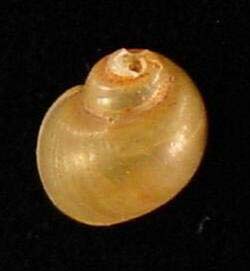
Gillia altilis, common name the Buffalo pebblesnail, is a species of freshwater snail, an aquatic gastropod mollusk with an operculum in the family Lithoglyphidae.
Tylomelania gemmifera is a species of freshwater snail with an operculum, an aquatic gastropod mollusk in the family Pachychilidae.









